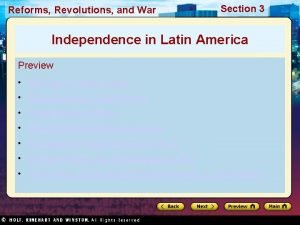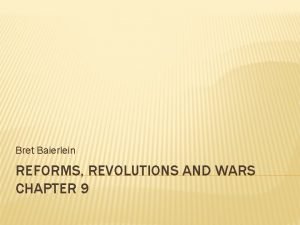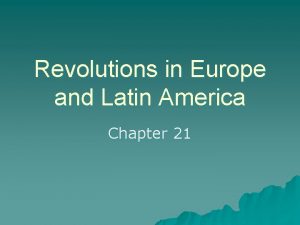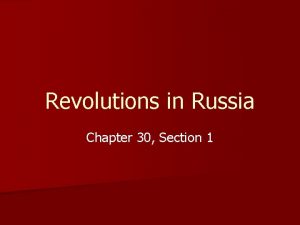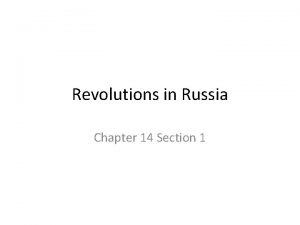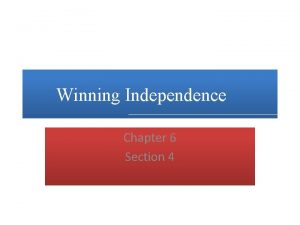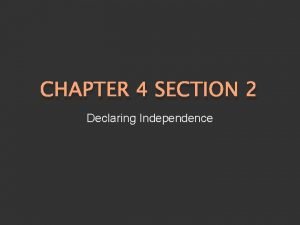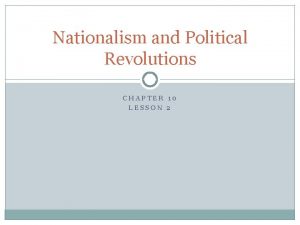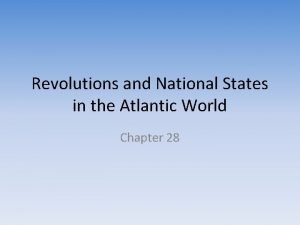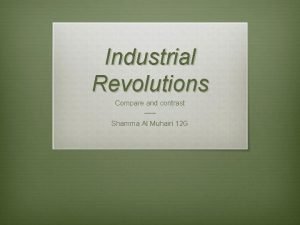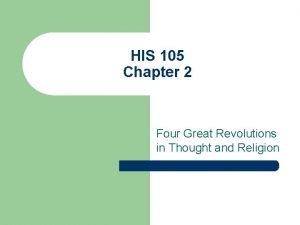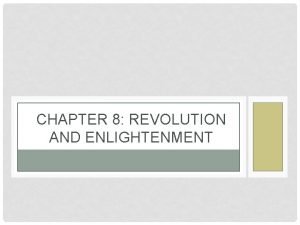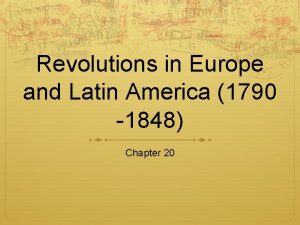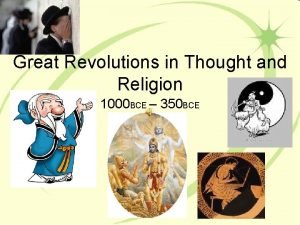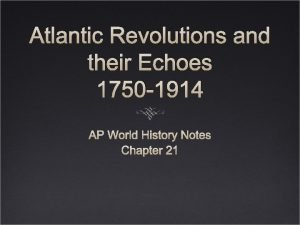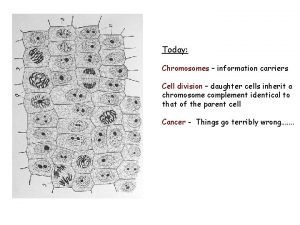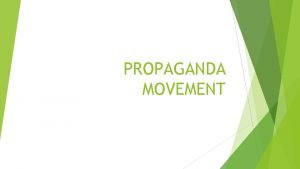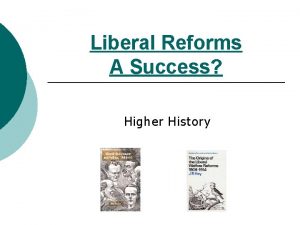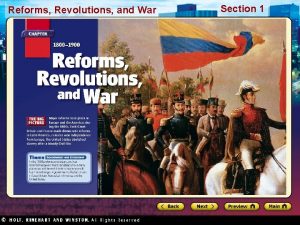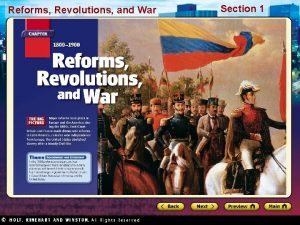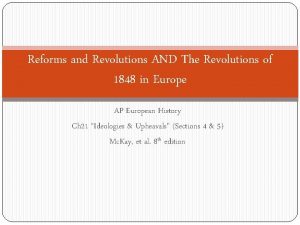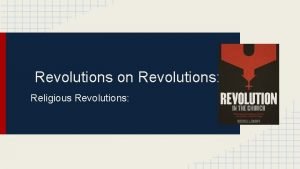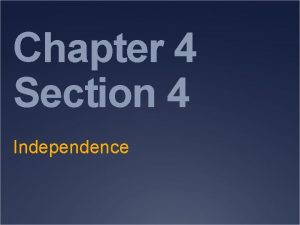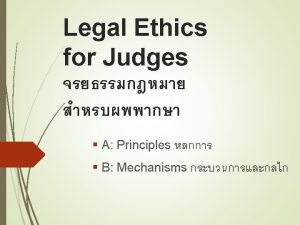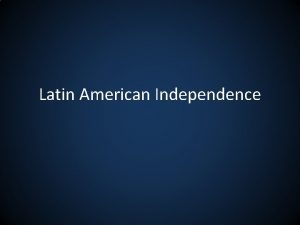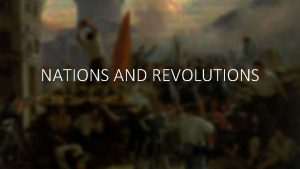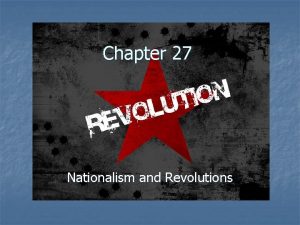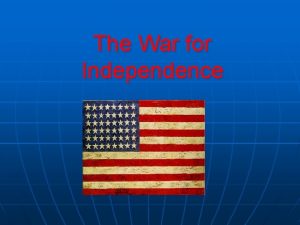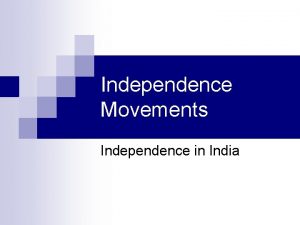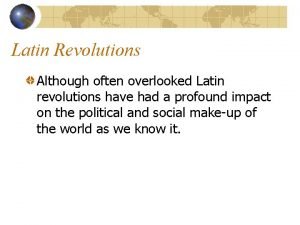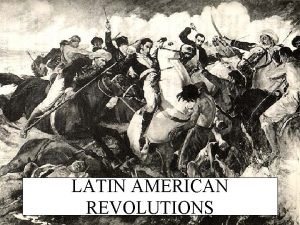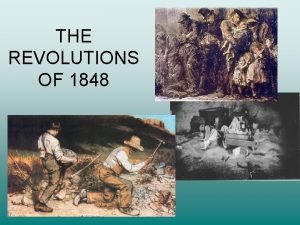Reforms Revolutions and War Section 3 Independence in






















- Slides: 22

Reforms, Revolutions, and War Section 3 Independence in Latin America Preview • Main Idea / Reading Focus • Early Struggles in Latin America • Independence in Mexico • Map: Independence in Latin America • Revolutionary Leaders in South America • Faces of History: Two Revolutionary Leaders • Quick Facts: Causes and Effects of Revolution in Latin America

Reforms, Revolutions, and War Section 3 Independence in Latin America Main Idea Revolutionary ideas took hold in Latin America as colonies fought for independence from Europe. Reading Focus • How did early struggles in Latin America affect Haiti and other colonies? • What events led to independence in Mexico? • Who were the key revolutionary leaders in South America, and what did they achieve?

Reforms, Revolutions, and War Section 3 Early Struggles in Latin America The Enlightenment and the American and French revolutions inspired some in Latin America to seek greater freedom.

Reforms, Revolutions, and War Section 3 Napoleon Concerned French emperor Napoleon worried about revolt in Hispaniola • Sent French general to take control of colony away from Toussaint – Island forces struggled for months – 1802, Toussaint agreed to armistice – French broke agreement, sent him to prison; Toussaint died there, 1803 • Fight for independence continued – 1804, revolutionaries declared independence – Named new nation Haiti

Reforms, Revolutions, and War Section 3 Colonies of Spain and Portugal Another Kind of Independence • 1800 s, Spain controlled most of Latin America; Portugal governed Brazil • In the 1700 s Spanish kings had made improvements in colonies, building roads, regulating trade; colonies grew in wealth and prosperity Education and New Ideas • Wealth gave some in Latin America access to education, new ideas • Educated colonists read works of Enlightenment philosophers, learned about revolutions in France, America Tensions Growing • Tensions grew in Latin America between creoles, people of European descent born in colonies, and peninsulares, colonists born in Spain • Similar distinction between Brazilian-born, Portuguese-born colonists

Reforms, Revolutions, and War Growing Tensions Section 3

Reforms, Revolutions, and War Section 3 Sequence How did Haiti win independence from France? Answer(s): A rebellion of slaves and mulattoes became a revolution against France after Napoleon tried to take power from the revolutionary leader Toussaint L'Ouverture.

Reforms, Revolutions, and War Section 3 Independence in Mexico Napoleon’s conquest of Spain was the spark for independence in the colony of New Spain, as Mexico was known at the time. Mexico was a Spanish colony with a mixture of creoles, peninsulares, Indians, and people of mixed race. Hidalgo would later become known as the Father of Mexican Independence.

Reforms, Revolutions, and War Section 3 Morelos Continues the Revolution • After death of Hidalgo, another creole priest, Jose Maria Morelos, became leader of revolutionary movement • Organized Mexican congress, representatives from many places • Wanted all people born in Mexico, whether Indian, mixed or creole, to be called Americans Independent Republic • Morelos wanted Mexico to be an independent republic with guaranteed freedoms • Strong military leader, took control of parts of Mexico for independence movement • Captured, found guilty of treason, executed by Spanish authorities

Reforms, Revolutions, and War Section 3 A Creole King for Mexico Iturbide to Lead Fight • Not all creoles wanted independence from Spain; some were royalists • 1820, Agustin de Iturbide asked to lead final battle against revolutionaries • Spanish authorities believed he could end Mexican independence movement Switching Sides • Iturbide believed liberal revolution underway in Spain might take away some of his power; decided to switch sides, fight for Mexican revolutionaries • Made three-part proposal to leader of revolution Iturbide’s Proposal • Mexico would gain independence but be ruled by monarch • Creoles and peninsulares would have equal rights • Roman Catholic Church would be official church of Mexico

Reforms, Revolutions, and War Section 3 Different Proposal • Iturbide’s independence proposal different from ideas of Hidalgo, Morelos • After ten years of fighting, the compromise brought together many different groups; creoles and peninsulares, revolutionaries and royalists Independence • Unified under plan, royalists and rebel troops joined Iturbide to win independence • In 1821, Mexico declared independence from Spain • That same year Mexico named Iturbide as its emperor and he became Emperor Agustin I of Mexico

Reforms, Revolutions, and War Section 3

Reforms, Revolutions, and War Section 3

Reforms, Revolutions, and War Section 3

Reforms, Revolutions, and War Section 3 Compare and Contrast How were the goals of Hidalgo, Morelos, and Iturbide different, and how were they similar? Answer(s): Hidalgo wanted the peasants to revolt against the peninsulares, not against Spain; Morelos wanted independence from Spain and an "American" identity to unify all people born in Mexico; Iturbide wanted to create an independent monarchy, give creoles and peninsulares equal rights, make the Roman Catholic Church the official church of Mexico

Reforms, Revolutions, and War Section 3 Revolutionary Leaders in South America Inspiration Simon Bolivar • Revolutions in Haiti, Mexico, America, France inspired leaders in South America • Simon Bolivar, most influential leader in South American independence movement • Independence movements began to form, leaders emerged • Known as “the Liberator” Venezuelan Roots Independence • Bolivar born into wealthy creole family, often traveled to Europe • 1811, Venezuela declared independence from Spain • Admired Napoleon’s leadership; in Rome, pledged to liberate South America • Bolivar led military campaigns against Spanish for 10 years, defeated Spanish 1821

Reforms, Revolutions, and War Section 3 Bolivar’s Dream Bolivar had dream for newly independent South America • Wanted to form one large, united country called Federation of the Andes • Dream never became reality – Bolivar set up state of Gran Colombia, included what are now Venezuela, Colombia, Panama, Ecuador – Other leaders set up separate countries in Peru, Bolivia, other places • Bolivar complained “America is ungovernable”

Reforms, Revolutions, and War Section 3

Reforms, Revolutions, and War Section 3 José de San Martin • José de San Martin fought for independence from Spain in south • San Martin had fought against Napoleon in Spain • Born in Argentina, returned home when he learned country rising up against Spanish rule; eventually led independence movement in Argentina and most of southern South America

Reforms, Revolutions, and War Section 3 Pedro I The story of independence was a bit different in the Portuguese colony of Brazil.

Reforms, Revolutions, and War Section 3

Reforms, Revolutions, and War Section 3 Contrast In what ways was the independence movement in Brazil different from independence movements elsewhere in South America? Answer(s): Brazil won independence more smoothly and without violence.
 Reforms revolutions and war answer key
Reforms revolutions and war answer key Wars revolutions and reforms
Wars revolutions and reforms Revolutions in europe and latin america section 1 quiz
Revolutions in europe and latin america section 1 quiz Revolutions in russia chapter 30 section 1
Revolutions in russia chapter 30 section 1 Chapter 14 section 1 revolutions in russia
Chapter 14 section 1 revolutions in russia What was the cause of deccan riot of 1875
What was the cause of deccan riot of 1875 Latin american peoples win independence chapter 8 section 1
Latin american peoples win independence chapter 8 section 1 Lesson 2 uniting for independence answer key
Lesson 2 uniting for independence answer key Chapter 6 section 4 winning independence
Chapter 6 section 4 winning independence Chapter 4 section 2 declaring independence
Chapter 4 section 2 declaring independence Toward civil war lesson 3 secession and war
Toward civil war lesson 3 secession and war Nationalism and political revolutions lesson 2
Nationalism and political revolutions lesson 2 Revolutions and national states in the atlantic world
Revolutions and national states in the atlantic world First and second industrial revolution
First and second industrial revolution Four great revolutions in thought and religion
Four great revolutions in thought and religion How were european rulers guided by enlightenment thought
How were european rulers guided by enlightenment thought Revolutions in europe and latin america
Revolutions in europe and latin america Aryan food
Aryan food Atlantic revolutions and their echoes
Atlantic revolutions and their echoes Tanzimat reforms definition
Tanzimat reforms definition Spindle fibers
Spindle fibers Msgr. pedro palaez
Msgr. pedro palaez Higher history effectiveness of the liberal reforms essay
Higher history effectiveness of the liberal reforms essay
